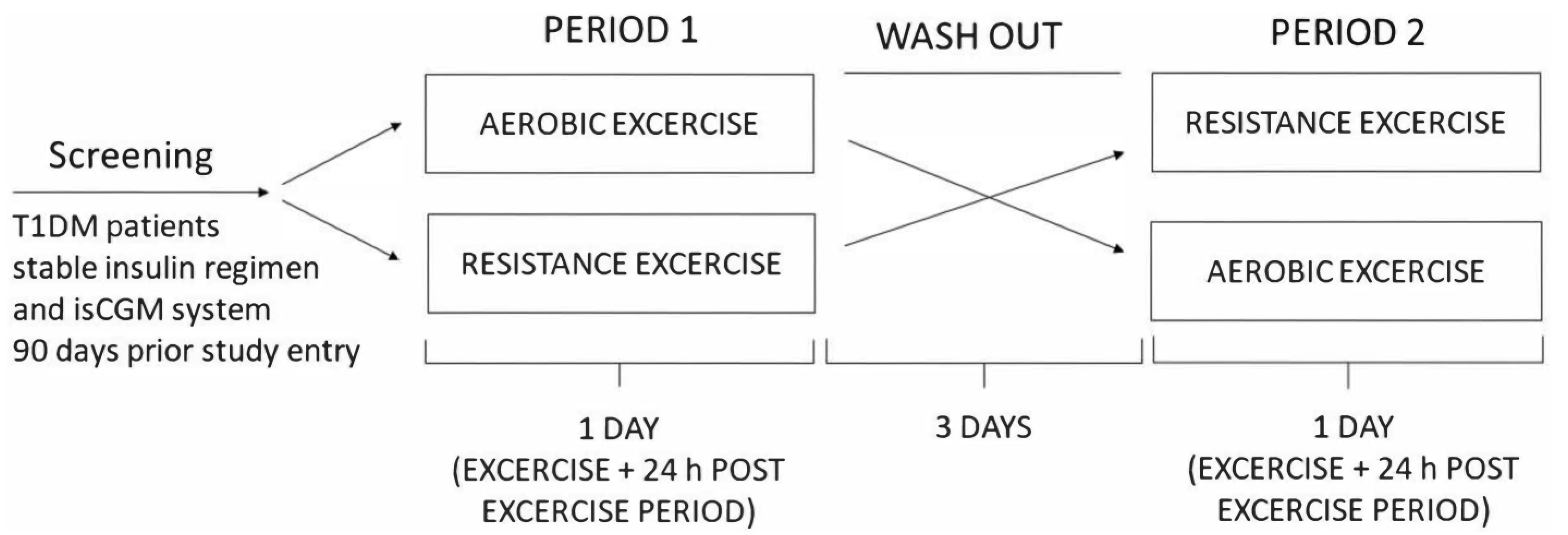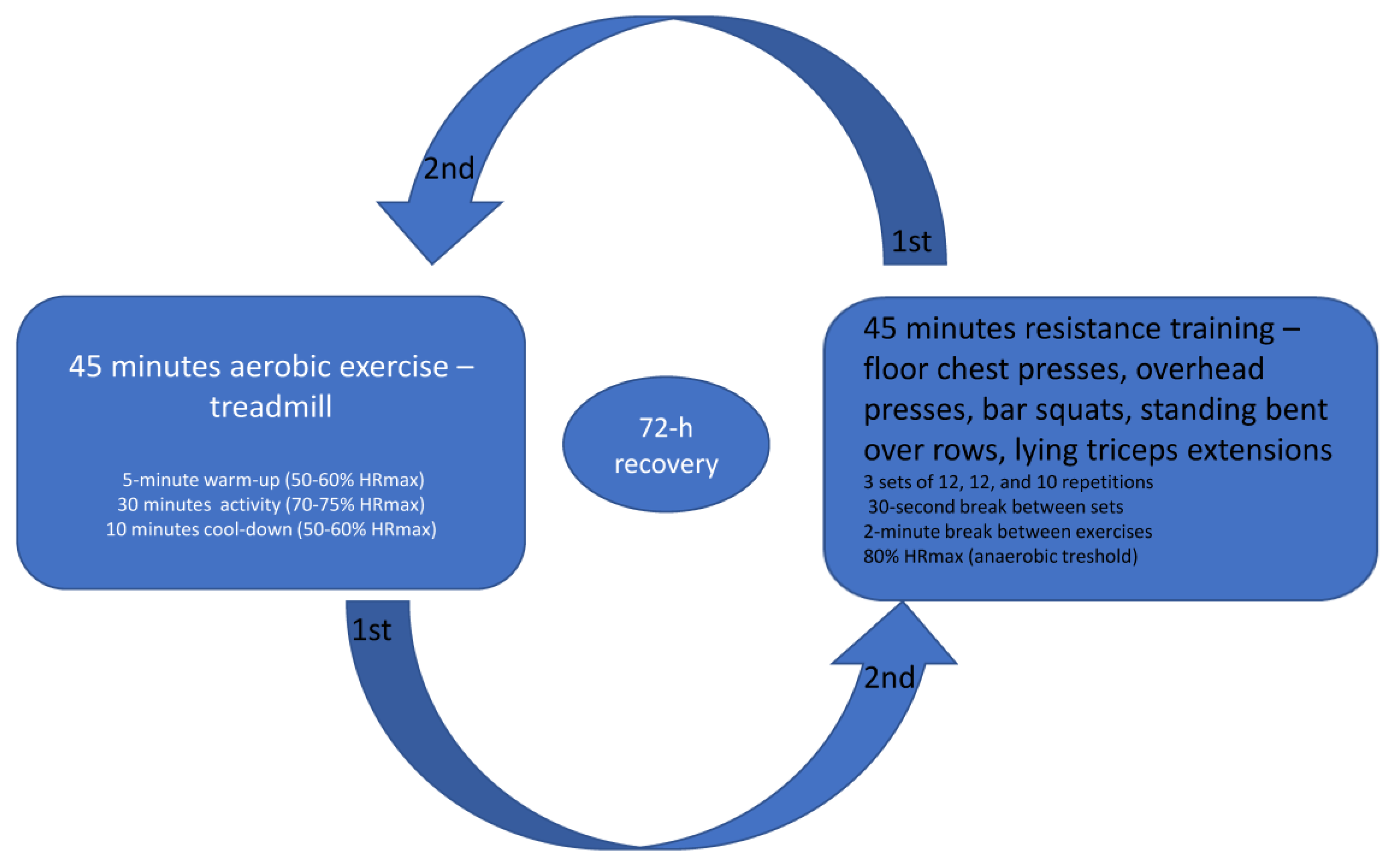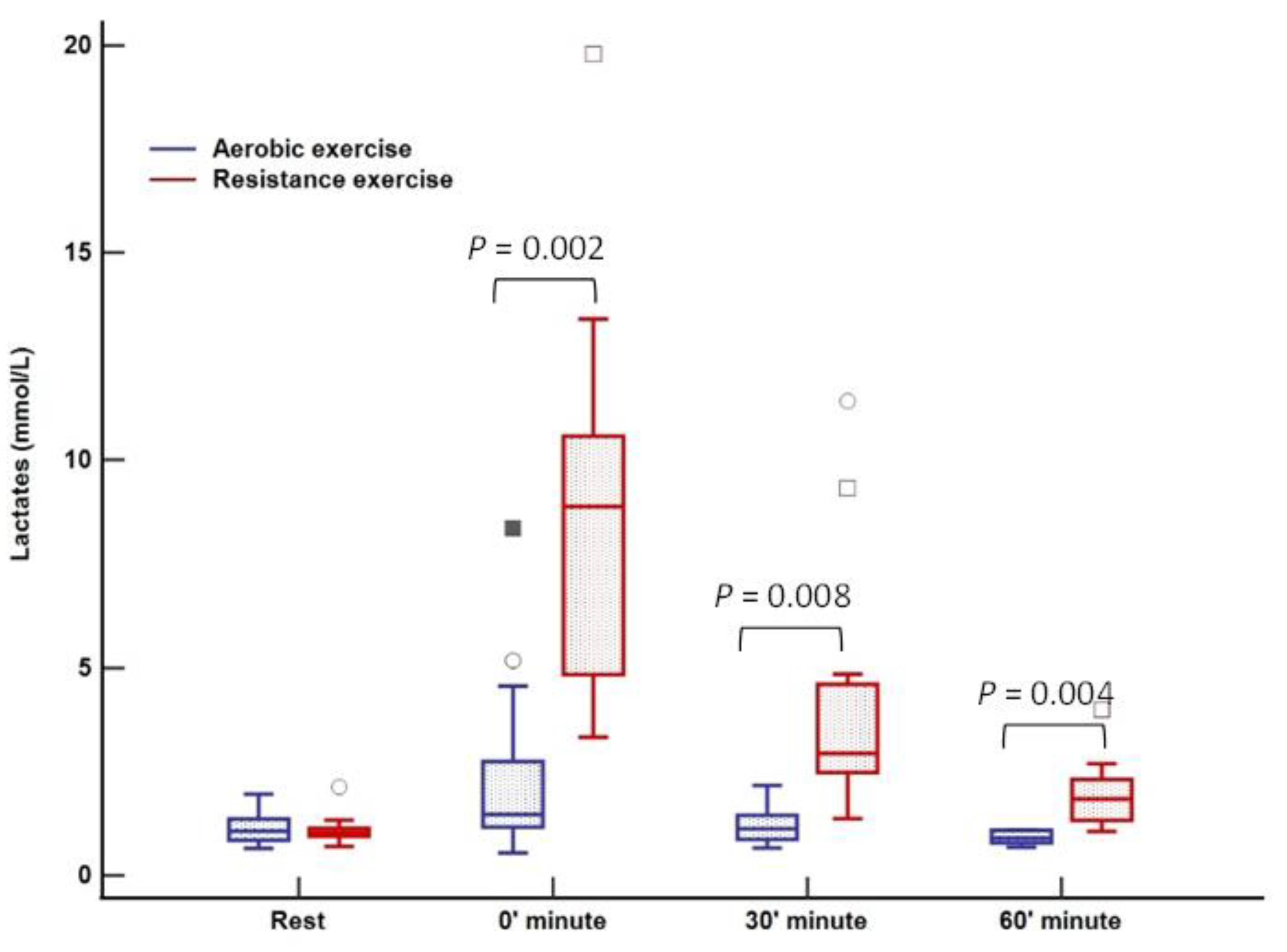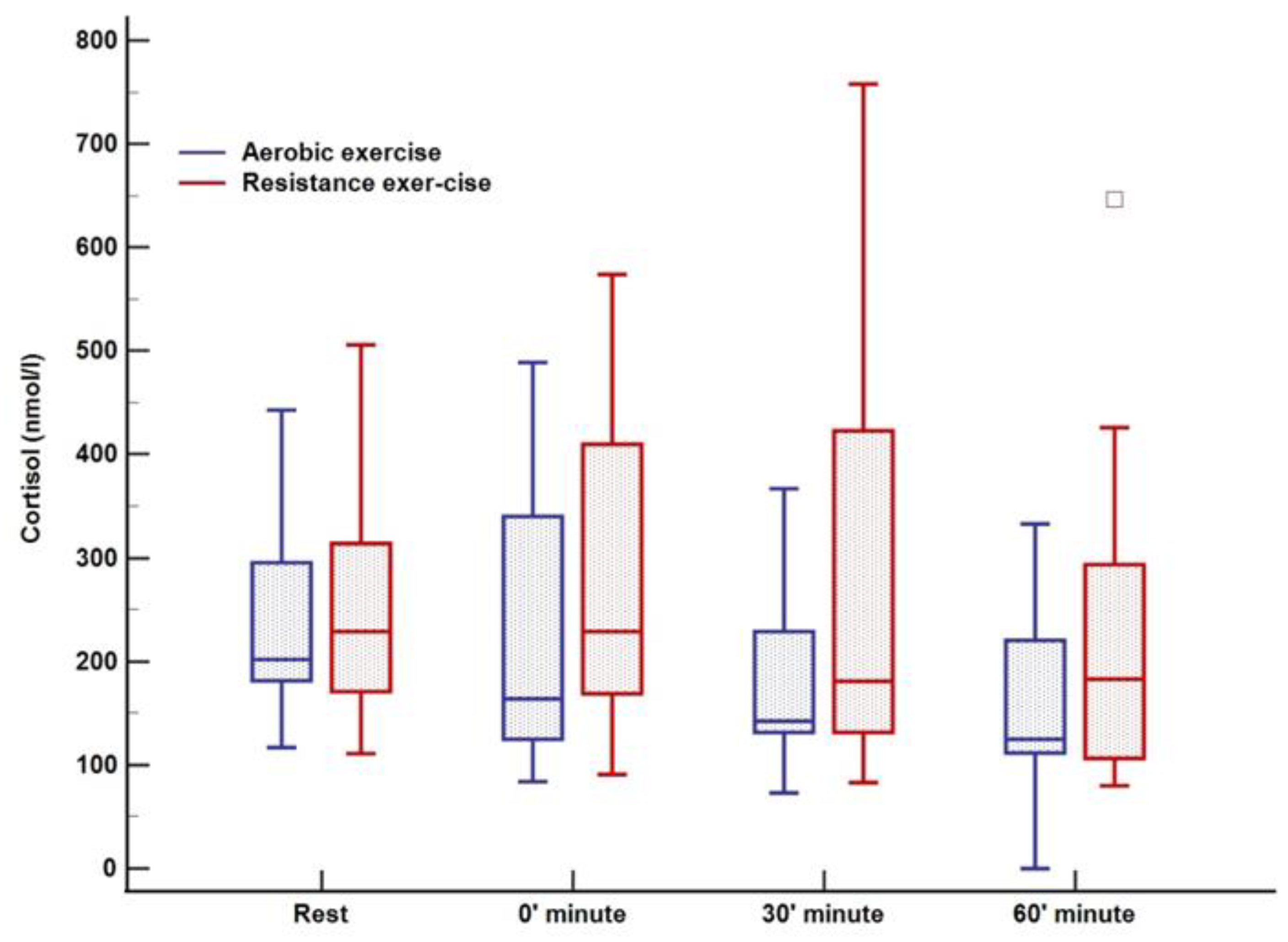Management of Glycemia during Acute Aerobic and Resistance Training in Patients with Diabetes Type 1: A Croatian Pilot Study
Abstract
1. Introduction
2. Materials and Methods
2.1. Participants
2.2. Experimental Design
2.3. Exercise Protocol
2.4. Statistical Methods
3. Results
4. Discussion
5. Conclusions
Author Contributions
Funding
Institutional Review Board Statement
Informed Consent Statement
Data Availability Statement
Conflicts of Interest
References
- Varkevisser, R.D.M.; Birnie, E.; Vollenbrock, C.E.; Mul, D.; van Dijk, P.R.; van der Klauw, M.M.; Veeze, H.; Wolffenbuttel, B.H.R.; Aanstoot, H.J. Cardiovascular risk management in people with type 1 diabetes: Performance using three guidelines. BMJ Open Diabetes. Res. Care 2022, 10, e002765. [Google Scholar] [CrossRef]
- Wu, N.; Bredin, S.S.D.; Guan, Y.; Dickinson, K.; Kim, D.D.; Chua, Z.; Kaufman, K.; Warburton, D.E.R. Cardiovascular Health Benefits of Exercise Training in Persons Living with Type 1 Diabetes: A Systematic Review and Meta-Analysis. J. Clin. Med. 2019, 8, 253. [Google Scholar] [CrossRef] [PubMed]
- Fitzpatrick, R.; Davison, G.; Wilson, J.J.; McMahon, G.; McClean, C. Exercise, type 1 diabetes mellitus and blood glucose: The implications of exercise timing. Front. Endocrinol. 2022, 13, 1021800. [Google Scholar] [CrossRef]
- Lu, X.; Zhao, C. Exercise and Type 1 Diabetes. Adv. Exp. Med. Biol. 2020, 1228, 107–121. [Google Scholar] [CrossRef] [PubMed]
- Alkhateeb, H.; El Fathi, A.; Ghanbari, M.; Haidar, A. Modelling glucose dynamics during moderate exercise in individuals with type 1 diabetes. PLoS ONE 2021, 16, e0248280. [Google Scholar] [CrossRef]
- Litchfield, I.; Andrews, R.C.; Narendran, P.; Greenfield, S. Patient and Healthcare Professionals Perspectives on the Delivery of Exercise Education for Patients with Type 1 Diabetes. Front. Endocrinol. 2019, 10, 76. [Google Scholar] [CrossRef] [PubMed]
- Cai, Y.; Xie, K.L.; Zheng, F.; Liu, S.X. Aerobic Exercise Prevents Insulin Resistance Through the Regulation of miR-492/Resistin Axis in Aortic Endothelium. J. Cardiovasc. Transl. Res. 2018, 11, 450–458. [Google Scholar] [CrossRef]
- Muñoz, V.R.; Gaspar, R.C.; Kuga, G.K.; da Rocha, A.L.; Crisol, B.M.; Botezelli, J.D.; Baptista, I.L.; Mekary, R.A.; da Silva, A.S.R.; Cintra, D.E.; et al. Exercise increases Rho-kinase activity and insulin signaling in skeletal muscle. J. Cell. Physiol. 2018, 233, 4791–4800. [Google Scholar] [CrossRef] [PubMed]
- Deichmann, J.; Bachmann, S.; Burckhardt, M.A.; Szinnai, G.; Kaltenbach, H.M. Simulation-Based Evaluation of Treatment Adjustment to Exercise in Type 1 Diabetes. Front. Endocrinol. 2021, 12, 723812. [Google Scholar] [CrossRef] [PubMed]
- Bracken, R.M.; Page, R.; Gray, B.; Kilduff, L.P.; West, D.J.; Stephens, J.W.; Bain, S.C. Isomaltulose improves glycemia and maintains run performance in type 1 diabetes. Med. Sci. Sports Exerc. 2012, 44, 800–808. [Google Scholar] [CrossRef] [PubMed]
- Campbell, M.D.; Walker, M.; Trenell, M.I.; Stevenson, E.J.; Turner, D.; Bracken, R.M.; Shaw, J.A.; West, D.J. A low-glycemic index meal and bedtime snack prevents postprandial hyperglycemia and associated rises in inflammatory markers, providing protection from early but not late nocturnal hypoglycemia following evening exercise in type 1 diabetes. Diabetes Care 2014, 37, 1845–1853. [Google Scholar] [CrossRef]
- Jung, A.R.; Kim, H.; Kim, H.S.; Kim, C.; Choi, W.S. Exercise Strategies to Prevent Hypoglycemia in Patients with Diabetes. Korean J. Fam. Med. 2021, 42, 91–95. [Google Scholar] [CrossRef]
- Bracken, R.M.; West, D.J.; Stephens, J.W.; Kilduff, L.P.; Luzio, S.; Bain, S.C. Impact of pre-exercise rapid-acting insulin reductions on ketogenesis following running in Type 1 diabetes. Diabet. Med. 2011, 28, 218–222. [Google Scholar] [CrossRef]
- West, D.J.; Stephens, J.W.; Bain, S.C.; Kilduff, L.P.; Luzio, S.; Still, R.; Bracken, R.M. A combined insulin reduction and carbohydrate feeding strategy 30 min before running best preserves blood glucose concentration after exercise through improved fuel oxidation in type 1 diabetes mellitus. J. Sports Sci. 2011, 29, 279–289. [Google Scholar] [CrossRef]
- Cockcroft, E.J.; Narendran, P.; Andrews, R.C. Exercise-induced hypoglycaemia in type 1 diabetes. Exp. Physiol. 2020, 105, 590–599. [Google Scholar] [CrossRef] [PubMed]
- Farinha, J.B.; Krause, M.; Rodrigues-Krause, J.; Reischak-Oliveira, A. Exercise for type 1 diabetes mellitus management: General considerations and new directions. Med. Hypotheses 2017, 104, 147–153. [Google Scholar] [CrossRef] [PubMed]
- Bally, L.; Zueger, T.; Buehler, T.; Dokumaci, A.S.; Speck, C.; Pasi, N.; Ciller, C.; Paganini, D.; Feller, K.; Loher, H.; et al. Metabolic and hormonal response to intermittent high-intensity and continuous moderate intensity exercise in individuals with type 1 diabetes: A randomised crossover study. Diabetologia 2016, 59, 776–784. [Google Scholar] [CrossRef]
- Turner, D.; Luzio, S.; Gray, B.J.; Dunseath, G.; Rees, E.D.; Kilduff, L.P.; Campbell, M.D.; West, D.J.; Bain, S.C.; Bracken, R.M. Impact of single and multiple sets of resistance exercise in type 1 diabetes. Scand. J. Med. Sci. Sports 2015, 25, e99–e109. [Google Scholar] [CrossRef] [PubMed]
- Pongrac Barlovic, D.; Harjutsalo, V.; Groop, P.H. Exercise and nutrition in type 1 diabetes: Insights from the FinnDiane cohort. Front. Endocrinol. 2022, 13, 1064185. [Google Scholar] [CrossRef]
- Davey, R.J.; Paramalingam, N.; Retterath, A.J.; Lim, E.M.; Davis, E.A.; Jones, T.W.; Fournier, P.A. Antecedent hypoglycaemia does not diminish the glycaemia-increasing effect and glucoregulatory responses of a 10 s sprint in people with type 1 diabetes. Diabetologia 2014, 57, 1111–1118. [Google Scholar] [CrossRef]
- Harmer, A.R.; Chisholm, D.J.; McKenna, M.J.; Morris, N.R.; Thom, J.M.; Bennett, G.; Flack, J.R. High-intensity training improves plasma glucose and acid-base regulation during intermittent maximal exercise in type 1 diabetes. Diabetes Care 2007, 30, 1269–1271. [Google Scholar] [CrossRef] [PubMed]
- Reddy, R.; Wittenberg, A.; Castle, J.R.; El Youssef, J.; Winters-Stone, K.; Gillingham, M.; Jacobs, P.G. Effect of Aerobic and Resistance Exercise on Glycemic Control in Adults With Type 1 Diabetes. Can. J. Diabetes 2019, 43, 406–414.e401. [Google Scholar] [CrossRef] [PubMed]
- Petschnig, R.; Wagner, T.; Robubi, A.; Baron, R. Effect of Strength Training on Glycemic Control and Adiponectin in Diabetic Children. Med. Sci. Sports Exerc. 2020, 52, 2172–2178. [Google Scholar] [CrossRef]
- de Abreu de Lima, V.; de Menezes, F.J.; da Rocha Celli, L.; França, S.N.; Cordeiro, G.R.; Mascarenhas, L.P.G.; Leite, N. Effects of resistance training on the glycemic control of people with type 1 diabetes: A systematic review and meta-analysis. Arch Endocrinol. Metab. 2022, 66, 533–540. [Google Scholar] [CrossRef]
- Campbell, M.D.; Walker, M.; Trenell, M.I.; Jakovljevic, D.G.; Stevenson, E.J.; Bracken, R.M.; Bain, S.C.; West, D.J. Large pre- and postexercise rapid-acting insulin reductions preserve glycemia and prevent early- but not late-onset hypoglycemia in patients with type 1 diabetes. Diabetes Care 2013, 36, 2217–2224. [Google Scholar] [CrossRef]
- Moser, O.; Riddell, M.C.; Eckstein, M.L.; Adolfsson, P.; Rabasa-Lhoret, R.; van den Boom, L.; Gillard, P.; Nørgaard, K.; Oliver, N.S.; Zaharieva, D.P.; et al. Glucose management for exercise using continuous glucose monitoring (CGM) and intermittently scanned CGM (isCGM) systems in type 1 diabetes: Position statement of the European Association for the Study of Diabetes (EASD) and of the International Society for Pediatric and Adolescent Diabetes (ISPAD) endorsed by JDRF and supported by the American Diabetes Association (ADA). Diabetologia 2020, 63, 2501–2520. [Google Scholar] [CrossRef]
- Schubert-Olesen, O.; Kröger, J.; Siegmund, T.; Thurm, U.; Halle, M. Continuous Glucose Monitoring and Physical Activity. Int. J. Environ. Res. Public Health 2022, 19, 12296. [Google Scholar] [CrossRef]
- Gomez, A.M.; Gomez, C.; Aschner, P.; Veloza, A.; Muñoz, O.; Rubio, C.; Vallejo, S. Effects of performing morning versus afternoon exercise on glycemic control and hypoglycemia frequency in type 1 diabetes patients on sensor-augmented insulin pump therapy. J. Diabetes Sci. Technol. 2015, 9, 619–624. [Google Scholar] [CrossRef]
- Davey, R.J.; Howe, W.; Paramalingam, N.; Ferreira, L.D.; Davis, E.A.; Fournier, P.A.; Jones, T.W. The effect of midday moderate-intensity exercise on postexercise hypoglycemia risk in individuals with type 1 diabetes. J. Clin. Endocrinol. Metab. 2013, 98, 2908–2914. [Google Scholar] [CrossRef] [PubMed]
- Toghi-Eshghi, S.R.; Yardley, J.E. Morning (Fasting) vs Afternoon Resistance Exercise in Individuals with Type 1 Diabetes: A Randomized Crossover Study. J. Clin. Endocrinol. Metab. 2019, 104, 5217–5224. [Google Scholar] [CrossRef] [PubMed]
- Valli, G.; Minnock, D.; Tarantino, G.; Neville, R.D. Delayed effect of different exercise modalities on glycaemic control in type 1 diabetes mellitus: A systematic review and meta-analysis. Nutr. Metab. Cardiovasc. Dis. 2021, 31, 705–716. [Google Scholar] [CrossRef]
- Bolinder, J.; Antuna, R.; Geelhoed-Duijvestijn, P.; Kröger, J.; Weitgasser, R. Novel glucose-sensing technology and hypoglycaemia in type 1 diabetes: A multicentre, non-masked, randomised controlled trial. Lancet 2016, 388, 2254–2263. [Google Scholar] [CrossRef]
- Haak, T.; Hanaire, H.; Ajjan, R.; Hermanns, N.; Riveline, J.P.; Rayman, G. Use of Flash Glucose-Sensing Technology for 12 months as a Replacement for Blood Glucose Monitoring in Insulin-treated Type 2 Diabetes. Diabetes Ther. 2017, 8, 573–586. [Google Scholar] [CrossRef]
- Reddy, M.; Jugnee, N.; El Laboudi, A.; Spanudakis, E.; Anantharaja, S.; Oliver, N. A randomized controlled pilot study of continuous glucose monitoring and flash glucose monitoring in people with Type 1 diabetes and impaired awareness of hypoglycaemia. Diabet. Med. 2018, 35, 483–490. [Google Scholar] [CrossRef] [PubMed]
- Yaron, M.; Roitman, E.; Aharon-Hananel, G.; Landau, Z.; Ganz, T.; Yanuv, I.; Rozenberg, A.; Karp, M.; Ish-Shalom, M.; Singer, J.; et al. Effect of Flash Glucose Monitoring Technology on Glycemic Control and Treatment Satisfaction in Patients With Type 2 Diabetes. Diabetes Care 2019, 42, 1178–1184. [Google Scholar] [CrossRef]
- Da Prato, G.; Pasquini, S.; Rinaldi, E.; Lucianer, T.; Donà, S.; Santi, L.; Negri, C.; Bonora, E.; Moghetti, P.; Trombetta, M. Accuracy of CGM Systems During Continuous and Interval Exercise in Adults with Type 1 Diabetes. J. Diabetes Sci. Technol. 2022, 16, 1436–1443. [Google Scholar] [CrossRef] [PubMed]
- Muñoz Fabra, E.; Díez, J.L.; Bondia, J.; Laguna Sanz, A.J. A Comprehensive Review of Continuous Glucose Monitoring Accuracy during Exercise Periods. Sensors 2021, 21, 479. [Google Scholar] [CrossRef]
- Fokkert, M.J.; van Dijk, P.R.; Edens, M.A.; Abbes, S.; de Jong, D.; Slingerland, R.J.; Bilo, H.J. Performance of the FreeStyle Libre Flash glucose monitoring system in patients with type 1 and 2 diabetes mellitus. BMJ Open Diabetes Res. Care 2017, 5, e000320. [Google Scholar] [CrossRef] [PubMed]
- Kanaley, J.A.; Weltman, J.Y.; Veldhuis, J.D.; Rogol, A.D.; Hartman, M.L.; Weltman, A. Human growth hormone response to repeated bouts of aerobic exercise. J. Appl. Physiol. 1997, 83, 1756–1761. [Google Scholar] [CrossRef] [PubMed]
- Weltman, A.; Weltman, J.Y.; Schurrer, R.; Evans, W.S.; Veldhuis, J.D.; Rogol, A.D. Endurance training amplifies the pulsatile release of growth hormone: Effects of training intensity. J. Appl. Physiol. 1992, 72, 2188–2196. [Google Scholar] [CrossRef]
- Sabag, A.; Chang, D.; Johnson, N.A. Growth Hormone as a Potential Mediator of Aerobic Exercise-Induced Reductions in Visceral Adipose Tissue. Front. Physiol. 2021, 12, 623570. [Google Scholar] [CrossRef] [PubMed]
- Bharti, N.; Hrubeniuk, T.; Mayo, A.; Sénéchal, M.; Bouchard, D.R. Resistance Training Contribute to the Aerobic Components of an Exercise Session in Adults but not as Much in Older Adults. Int. J. Exerc. Sci. 2017, 10, 406–416. [Google Scholar] [PubMed]
- Kanaley, J.A.; Weltman, J.Y.; Pieper, K.S.; Weltman, A.; Hartman, M.L. Cortisol and growth hormone responses to exercise at different times of day. J. Clin. Endocrinol. Metab. 2001, 86, 2881–2889. [Google Scholar] [CrossRef] [PubMed]
- King, A.; Helms, E.; Zinn, C.; Jukic, I. The Ergogenic Effects of Acute Carbohydrate Feeding on Resistance Exercise Performance: A Systematic Review and Meta-analysis. Sports Med. 2022, 52, 2691–2712. [Google Scholar] [CrossRef] [PubMed]
- Cerretelli, P.; Samaja, M. Acid-base balance at exercise in normoxia and in chronic hypoxia. Revisiting the "lactate paradox". Eur. J. Appl. Physiol. 2003, 90, 431–448. [Google Scholar] [CrossRef]
- Podolin, D.A.; Munger, P.A.; Mazzeo, R.S. Plasma catecholamine and lactate response during graded exercise with varied glycogen conditions. J. Appl. Physiol. 1991, 71, 1427–1433. [Google Scholar] [CrossRef]





| Parameter | Median (IQR) 1 | Minimum–Maximum |
|---|---|---|
| Age (years) | 53 (43–57) | 22–60 |
| Duration of diabetes (years) | 30 (20–40) | 1–53 |
| HbA1c % | 7.1 (6.35–7.83) | 5.4–9 |
| BMI (kg/m2) | 24.5 (23.07–26.42) | 21.2–29.7 |
| Gender (N) | Females 9 | Males 5 |
| Aerobic Exercise | Glucose Level Median (IQR) | p * | Resistance Exercise | Glucose Level Median (IQR) |
|---|---|---|---|---|
| Rest | 9.2 (8.2–11.2) | 0.001 † | Rest | 10.3 (6.4–11.8) |
| 0′ min | 7.9 (6.4–11.1) | 0′ | 8.1 (7.3–11.4) | |
| 30′ min | 8.5(7.3–12.7) | 30′ minute | 8.75 (7.6–12.4) | |
| 60′ min | 9.6 (8.6–12.9) | 60′ minute | 9.45 (7.2–12.8) | |
| 6 h | 7.7 (6.1–11.0) | 6 h | 7.3 (6.2–9.9) | |
| 12 h | 7.4 (4.9–10.6) | 12 h | 7.7 (6–13) | |
| 24 h | 6.9 (5.4–8.2) | 24 h | 6.4 (4.4–9.2) |
| Glucose Level Median (IQR) | Hodges–Lehmann Median Difference | 95% CI | p * | |
|---|---|---|---|---|
| Prior AE | 9.2 (8.2–11.2) | −0.15 | −2.5 to 2.2 | 0.95 |
| Prior RE | 10.3 (6.4–11.8) | |||
| 0′ AE | 7.9 (6.4–11.1) | 1.10 | −1.1 to 2.9 | 0.36 |
| 0′ RE | 8.1 (7.3–11.4) | |||
| 30′ AE | 8.5 (7.3–12.7) | −0.15 | −2.25 to 2.05 | 0.90 |
| 30′ RE | 8.75 (7.6–12.4) | |||
| 60′ AE | 9.6 (8.6–12.9) | −0.70 | −3.25 to 1.7 | 0.54 |
| 60′ RE | 9.45 (7.2–12.8) | |||
| 6 h AE | 7.7 (6.1–11.0) | −0.25 | −3.2 to 1.7 | 0.79 |
| 6 h RE | 7.3 (6.2–9.9) | |||
| 12 h AE | 7.4 (4.9–10.6) | 1.1 | −1.4 to 3.4 | 0.33 |
| 12 h RE | 7.7 (6–13) | |||
| 24 h AE | 6.9 (5.4–8.2) | 0.75 | −1.7 to 2.5 | 0.54 |
| 24 h RE | 6.4 (4.4–9.2) |
| Median (IQR) | Hodges–Lehmann Median Difference | 95% CI | p * | |
|---|---|---|---|---|
| Number of hypoglycemia 24 h after aerobic exercise | 1 (0–2) | −0.5 | −1 to 0.5 | 0.25 |
| Number of hypoglycemia 24 h after resistance exercise | 1 (0–1) | |||
| Time to hypoglycemia onset after aerobic exercise (hours) | 13 (5–20) | 4 | −3 to 9.5 | 0.30 |
| Time to hypoglycemia onset after resistance exercise (hours) | 18 (13.5–21.5) | |||
| Duration of hypoglycemia (min)–24 h after aerobic exercise | 60 (0–220) | −17 | −105 to 30 | 0.50 |
| Duration of hypoglycemia (min)–24 h after resistance exercise | 65 (0–120) | |||
| Average glucose level 24 h after aerobic exercise (mmol/L) | 7.8 (6.78–9.75) | −0.15 | −1 to 0.7 | 0.57 |
| Average glucose level 24 h after resistance exercise (mmol/L) | 7.3 (6.55–9.03) |
| Number of patients | Number (%) | Diff. | 95% CI | p * | |
|---|---|---|---|---|---|
| Aerobic Exercise | Resistance Exercise | ||||
| Total hypoglycemic episodes | 14 | 14 | 7.1% | −29.7 to 43.9 | >0.99 |
| Nocturnal hypoglycemic episodes | 4 | 0 | 30.8% | 5.7 to 55.9 | 0.13 |
| Time Point | Median (IQR) | Difference † | 95% CI | p * | |
|---|---|---|---|---|---|
| Aerobic | Resistance | ||||
| Lactates (mmol/L) | |||||
| Rest | 1.12 (0.88–1.48) | 1.02 (0.91–1.17) | −0.10 | −0.51 to 0.24 | 0.73 |
| 0 min | 1.47 (1.20–3.35) | 9.01 (4.62–10.67) | 5.79 | 2.48 to 9.42 | 0.002 |
| 30 min | 1.12 (0.83–1.44) | 2.73 (2.35–5.60) | 2.37 | 0.80 to 5.89 | 0.008 |
| 60 min | 0.93 (0.83–1.09) | 1.83 (1.21–2.05) | 0.74 | 0.41 to 1.25 | 0.004 |
| Cortisol (nmol/L) | |||||
| Rest | 202 (181.5–295.5) | 270 (201.3 to 337.3) | 13.5 | −49 to 158.5 | 0.58 |
| 0 min | 164 (125–340.3) | 230 (178.8–415.5) | 36.5 | −59 to 188.5 | 0.41 |
| 30 min | 142.5 (131.5–229) | 198 (140–466) | 52.5 | −18.5 to 274 | 0.15 |
| 60 min | 123 (110.5–237) | 185 (128.5–315.5) | 46.5 | −6 to 127.9 | 0.08 |
| GH (μmol/L) | |||||
| Rest | 0.343 (0.103–0.727) | 0.203 (0.126–0.304) | −0.04 | −0.681 to 0.541 | 0.76 |
| 0 min | 1.46 (0.672–7.437) | 4.85 (1.465–7.105) | 1.26 | −0.289 to 3.085 | 0.17 |
| 30 min | 0.612 (0.409–1.844) | 1.798 (0.625–3.399) | 0.48 | −0.197 to 5.583 | 0.18 |
| 60 min | 0.723 (0.161–0.974) | 0.853 (0.560–1.489) | 0.31 | −0.490 to 0.959 | 0.30 |
Disclaimer/Publisher’s Note: The statements, opinions and data contained in all publications are solely those of the individual author(s) and contributor(s) and not of MDPI and/or the editor(s). MDPI and/or the editor(s) disclaim responsibility for any injury to people or property resulting from any ideas, methods, instructions or products referred to in the content. |
© 2023 by the authors. Licensee MDPI, Basel, Switzerland. This article is an open access article distributed under the terms and conditions of the Creative Commons Attribution (CC BY) license (https://creativecommons.org/licenses/by/4.0/).
Share and Cite
Ivandic, M.; Cigrovski Berkovic, M.; Ormanac, K.; Sabo, D.; Omanovic Kolaric, T.; Kuna, L.; Mihaljevic, V.; Canecki Varzic, S.; Smolic, M.; Bilic-Curcic, I. Management of Glycemia during Acute Aerobic and Resistance Training in Patients with Diabetes Type 1: A Croatian Pilot Study. Int. J. Environ. Res. Public Health 2023, 20, 4966. https://doi.org/10.3390/ijerph20064966
Ivandic M, Cigrovski Berkovic M, Ormanac K, Sabo D, Omanovic Kolaric T, Kuna L, Mihaljevic V, Canecki Varzic S, Smolic M, Bilic-Curcic I. Management of Glycemia during Acute Aerobic and Resistance Training in Patients with Diabetes Type 1: A Croatian Pilot Study. International Journal of Environmental Research and Public Health. 2023; 20(6):4966. https://doi.org/10.3390/ijerph20064966
Chicago/Turabian StyleIvandic, Marul, Maja Cigrovski Berkovic, Klara Ormanac, Dea Sabo, Tea Omanovic Kolaric, Lucija Kuna, Vjera Mihaljevic, Silvija Canecki Varzic, Martina Smolic, and Ines Bilic-Curcic. 2023. "Management of Glycemia during Acute Aerobic and Resistance Training in Patients with Diabetes Type 1: A Croatian Pilot Study" International Journal of Environmental Research and Public Health 20, no. 6: 4966. https://doi.org/10.3390/ijerph20064966
APA StyleIvandic, M., Cigrovski Berkovic, M., Ormanac, K., Sabo, D., Omanovic Kolaric, T., Kuna, L., Mihaljevic, V., Canecki Varzic, S., Smolic, M., & Bilic-Curcic, I. (2023). Management of Glycemia during Acute Aerobic and Resistance Training in Patients with Diabetes Type 1: A Croatian Pilot Study. International Journal of Environmental Research and Public Health, 20(6), 4966. https://doi.org/10.3390/ijerph20064966







